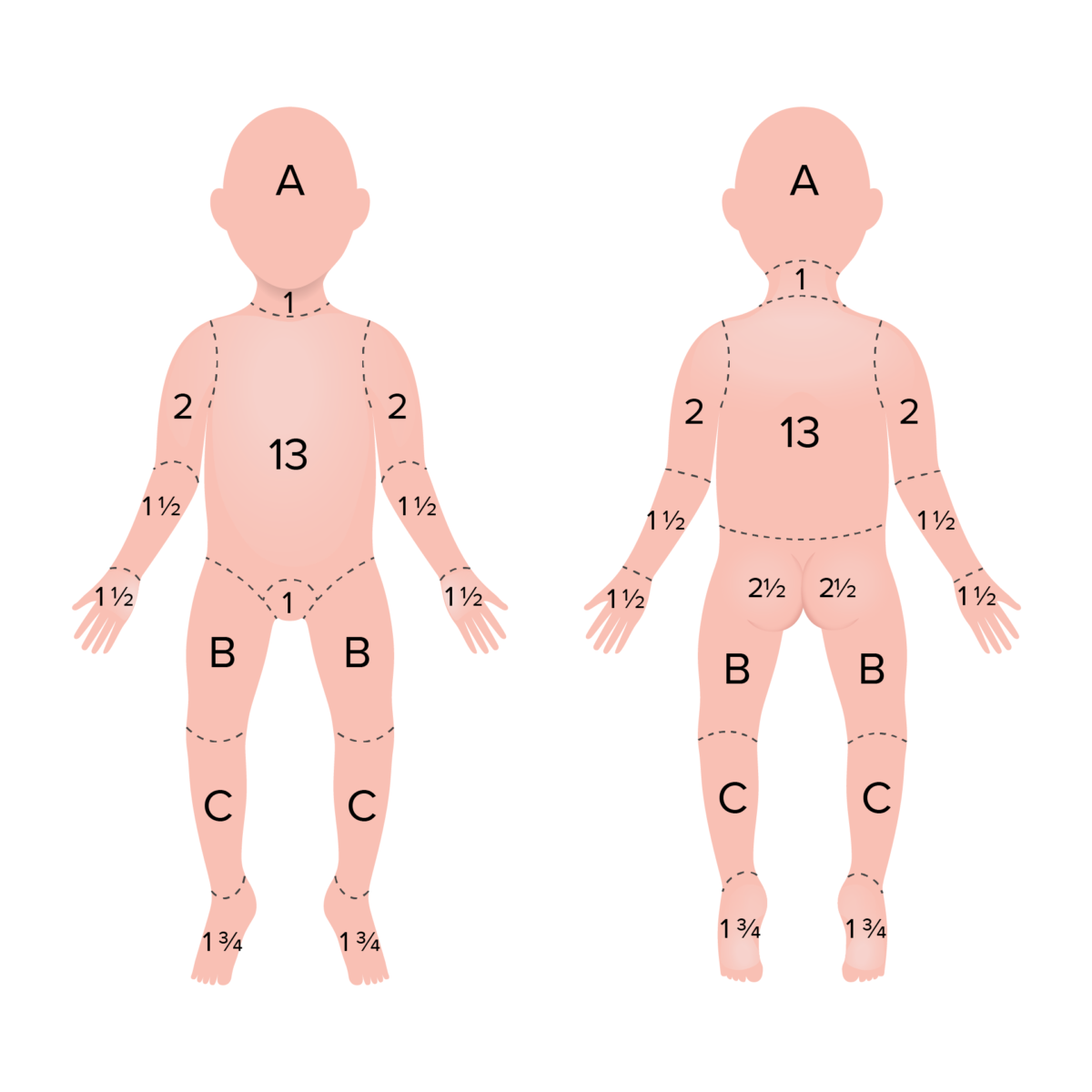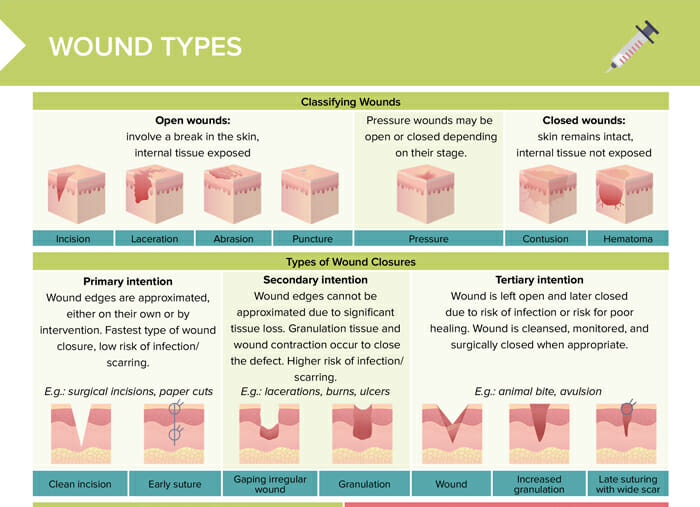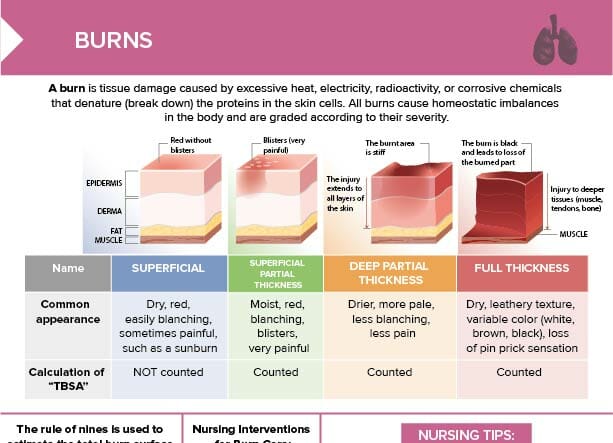What is a burn?
A burn is tissue damage caused by excessive heat, electricity, radioactivity, or corrosive chemicals that denature (break down) the proteins in the skin cells. All burns cause homeostatic imbalances in the body and are graded according to their severity.
Types of burns: classification
Burns are classified based on their depth (superficial–full thickness; first–third-degree burns), size of total body surface area (TBSA), and location (with some areas considered more serious than others due to higher potential for complications).
Burn classification chart
| Superficial | Superficial partial thickness | Deep partial thickness | Full thickness |
| Only epidermis; red without blisters | Dermis; blisters (very painful) | Burnt area is stiff; injury extends to all layers of the skin. | Burn is black and leads to loss of the burnt part. Injury to deeper tissues is present (muscle, tendons, bone). |
Superficial burns (first-degree burns)
- Only affect outer layer of the skin
- Dry, red, easily blanching, no blistering
- Sometimes painful, such as a sunburn
- NOT counted in TBSA
Superficial partial thickness (second-degree burns)
- Extend to the dermis
- Moist, red, blanching, blisters
- Very painful
- May result in scarring
Deep partial thickness and full thickness burns (third-degree burns)
- Deep partial thickness:
- Drier, more pale, less blanching
- Less pain due to damaged nerve endings
- Full thickness:
- Dry, leathery texture
- Variable color (white, brown, black)
- Loss of pin prick sensation
What is TBSA?
TBSA stands for Total Body Surface Area. It is used to estimate the percentage of the body surface that has been burned. This is an important part of initial burn assessment as it helps to determine the severity of the burn, guides fluid resuscitation, and aids in planning further treatment.
A common method to estimate the TBSA in adults is the “Rule of Nines”, which divides the body into sections of 9% (or multiples thereof). For example, each arm represents 9% of the body, each leg 18%, the torso 18% front and 18% back, and the head 9%.
In children, due to the proportionally larger head size, different percentages are used, often requiring specific pediatric burn charts.

Rule of 9 in children used to determine the TBSA of burn: percentages adjusted to more closely resemble adults
Area A represents 8.5% TBSA in a 1 year old, 6.5% in a 5 year old, 5.5% in a 10 year old and 4.5% in a 15 year old.
Area B represents 3.25% TBSA in a 1 year old, 4.0% in a 5 year old, 4.5% in a 10 year old and 4.5% in a 15 year old.
Area C represents 2.5% TBSA in a 1 year old, 2.75% in a 5 year old, 3.0% in a 10 year old and 3.25% in a 15 year old.
How to take care of a burn
Nursing interventions and tips for burn care
- Monitor for hypothermia.
- Assess breathing; assess for burns involving face, mouth, or smoke inhalation (singed facial hair, smoke debris around mouth) that may compromise airway and need intubation.
- Maintain C spine.
- Conduct neurological assessment.
- Facilitate transfer to specialized burn unit for extensive burn injuries, genital burns, high-voltage and chemical burns, and pediatric burns.
- Hyperkalemia is likely to occur as a result of cell lysing. Remember, potassium lives inside the cell. As cells lyse, potassium effluxes into blood circulation.
How to care for a second-degree burn
Caring for a client with second-degree burns involves:
- Assess the burn wound and the client’s status
- Managing pain
- Cleaning and dressing wound, monitoring for infection regularly
- Client education about wound care and nutritional support
- Emotional support for pain and potential changes in appearance and functionality
- Documentation
How to care for burn blisters
- Evaluate the blister for size, location, signs of infection, client’s pain levels.
- Apply sterile burn dressing to intact blisters.
- Administer pain medication as ordered.
- Always watch for signs of infection.
- Educate client to not pop blisters. Only in exceptions does the blister need to be de-roofed by a healthcare professional.
- Documentation of care
Nursing diagnoses for burns
Nursing diagnoses for burns can be quite diverse, depending on the severity and location of the burn. Some common nursing diagnoses for burns might include:
- Impaired skin integrity: related to thermal injury
- Acute pain: related to exposed nerve endings and inflammation
- Fluid volume deficit: related to fluid loss from the burn wound and increased vascular permeability
- Impaired physical mobility: due to pain, edema, or joint contractures
- Ineffective thermoregulation: due to loss of skin’s insulating function
- Altered nutrition: due to hypermetabolic state associated with burn injury
- Risk for infection: due to the loss of skin’s protective function
Becoming a burn care nurse
Burn unit nurses are critical care nurses specialized on treating clients with burn injuries.
They may work in a specialized burn unit, emergency department, intensive care unit, or outpatient care setting. This role requires strong clinical skills, a compassionate approach, and the ability to support clients and families through potentially long and difficult recovery processes.
To become a burn unit nurse, you will likely first need to gain a couple of years of acute or critical care experience after obtaining your nursing license. A certification like the Certified Wound Care Nurse credential or the Certified Pediatric Emergency Nurse can also help when applying for positions in burn units.

